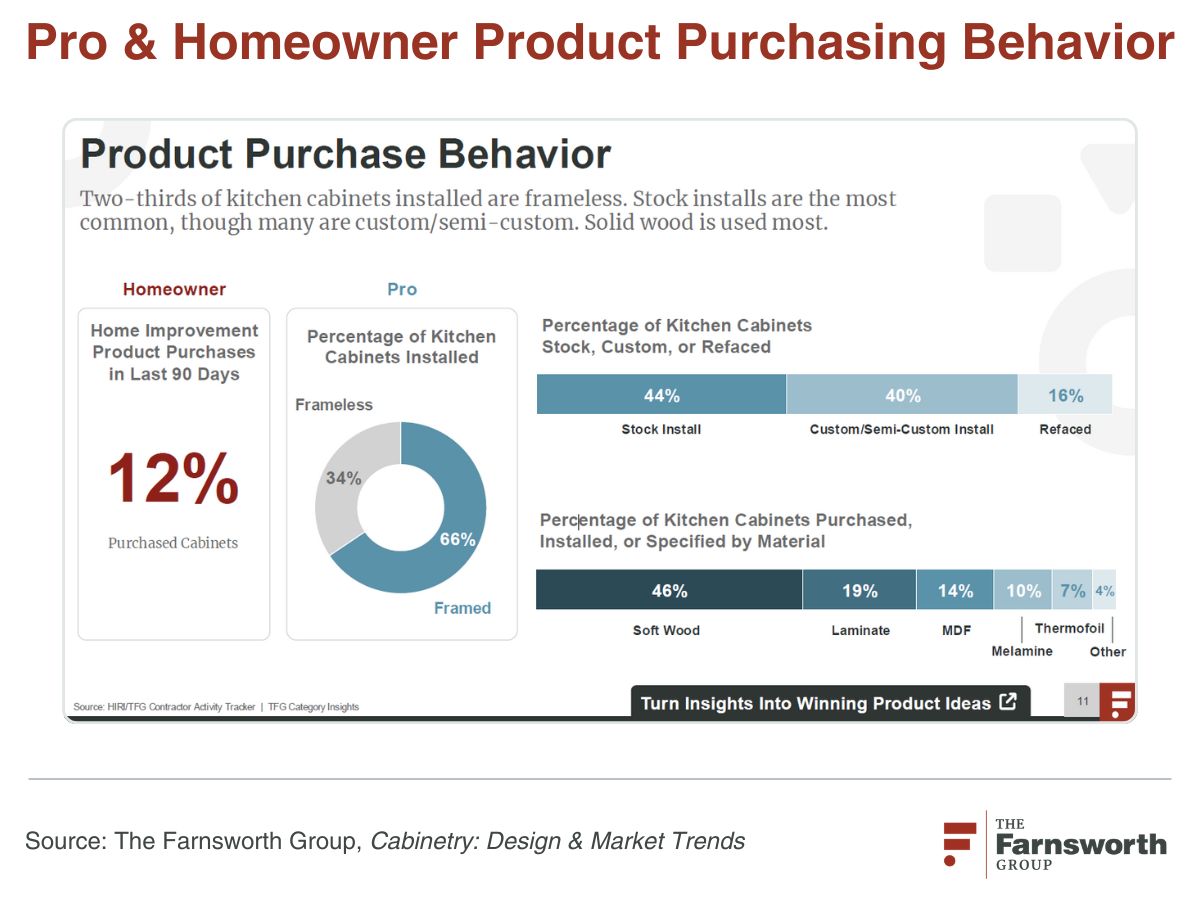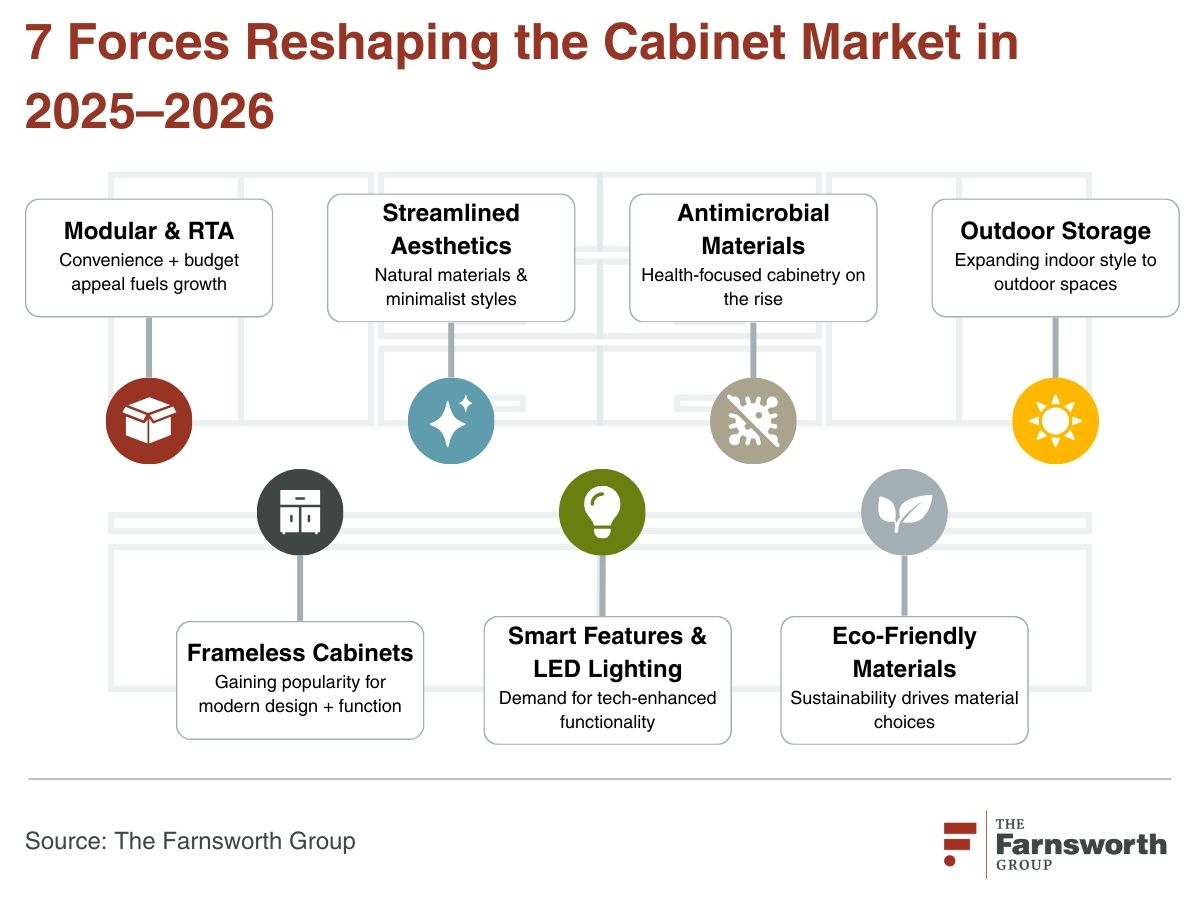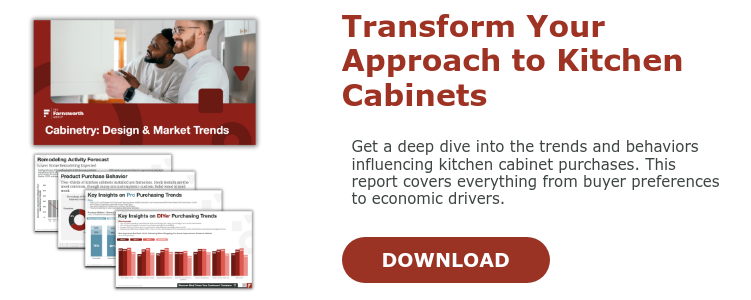It is often said that the kitchen is the heart of the home, where life really happens. Individuals and families spend hours in their kitchen; cooking, cleaning, eating, socializing, and hosting their friends and loved ones. In a similar way, bathrooms are an integral part of the home, a source of relaxation, privacy, and restoration that is utilized every day. For both spaces, cabinetry is a key component, both in terms of functionality and aesthetic appeal.
While the main purpose of cabinetry remains the same from year to year, namely, to provide useful storage space, the market for this product category is constantly evolving as new materials, technologies, manufacturing processes, and styles influence the preferences of both residential and commercial customers.
What is the Cabinet Market Size and Industry Outlook in 2025?
The global cabinetry market is composed of various storage elements, including cupboards, shelves, and pantries. Framed and Frameless cabinets can vary in type—from custom, semi-custom, and stock to modular or ready-to-assemble options—as well as style, including traditional, modern, shaker, slab and glass. Materials can vary from solid wood, MDF, engineered wood, or particle board, and coatings can range from paint, stain, foil, among others.
Driven by both the remodeling and new construction industries, the cabinetry market has remained strong for the past few years, despite a slight setback in 2023, and is expected to increase at a compound annual growth rate (CAGR) moving forward. Some of the factors contributing to this growth in spending include technological advancements in materials and manufacturing processes, increasing awareness about sustainability and eco-friendly materials, a growing demand for customization and personalization, and increasing urbanization.
However, the economic uncertainties and changing market conditions facing the home improvement and building industries in 2025 may impact these estimates. In the United States, in particular, there is reason for caution. The National Kitchen and Bath Association (NKBA) recently released its mid-year update, which reveals a rocky start to 2025, with a slight decline in bath and kitchen spending for labor and materials, which is likely to affect the cabinet market. While pro-led renovations are expected to increase marginally, the DIY segment shows signs of declining in the next few months. NKBA reports that while some consumers are holding off or postponing large-scale projects until they are certain of economic conditions, other consumers are proceeding with remodeling projects, sometimes selecting smaller, lesser cost products.
At the time of our reporting on Cabinetry: Design and Market Trends, about 12% of homeowners purchased cabinets in the past 90 days. Soft wood is the leading type of material for kitchen cabinets, followed by laminate and medium-density fiberboard (MDF). Though we often experience qualitative research results where customers may not be confident in identifying the material of their cabinet construction.

Consumer Demand for Organization and Storage Solutions
Consumer demand for space-saving storage that makes the most of small spaces or efficiently organizes their homes is expected to continue to drive cabinet product demand as well.
Additional reasons for cabinet market growth have to do with the growing influence of different channels for retail. Both in-store and online retail channels are important in the growth of the cabinet market, but e-commerce specifically has increased in cabinet purchases. Many of the large cabinet manufacturers have begun to open online stores and implement additional measures for online applications or software to increase their e-commerce-based sales.
To reach potential customers in the cabinet market it is essential to understand customer demand conditions as well as how potential customers are making decisions on cabinet selection.
The Farnsworth Group has conducted numerous studies for cabinet manufacturers, distributors or retailers. Learn more about how The Farnsworth Group helped a leading cabinet manufacturer identify their greatest market potential for customer growth through a custom market research study.
Quality and Availability Are Top Purchase Drivers
Data from our 2025 Cabinetry Report show that high quality and availability are the two most important factors for both DIY homeowners and industry professionals when selecting building products brands to use for various projects. Some of the cabinetry brands with the highest rate of brand preference include Hampton Bay, IKEA, Kraftmaid, and Allen + Roth Cabinetry. These brands also score high in overall brand performance, which is an average of brand characteristics that shows how well the brand performs in the field and compared to other products. Also take note that some of these brands are often considered entry price point, low price point, or provide a range of budget options. Highlighting the consumers potential shift towards budget friendly options in our current market.
What are Key Cabinet Trends for 2025 and 2026?
Staying up to date with the latest trends, technological advancements, and customer sentiments within the cabinet market puts manufacturers, distributors, and retailers in a more advantageous position. These insights can inform strategic decision-making and embolden industry stakeholders to take proactive steps to adapt, anticipate change, identify growth and product expansion opportunities.

Here is a look at some of the trends currently affecting the outlook for the cabinetry market in the second half of 2025 and into 2026:
1. Higher Demand for Modular and Ready-to-Assemble Cabinetry
Modular kitchen systems have witnessed growing demand, as space-saving and functional aesthetics are prioritized. More than half of new homeowners opt for modular kitchen layouts, driven by convenience, ease of installation, and customizations, according to Global Growth Insights. Additionally, ready-to-assemble cabinets (RTA) are one of the fastest growing segments of the cabinet industry due to the low cost and high convenience factor. The demand for RTA cabinets is being driven strongly by budget constraints on many US consumers and the economic slowdown. RTA cabinets are increasingly available on e-commerce platforms and have grown in quality and the variety of product offerings available.
2. Demand for Frameless Cabinets
Although framed cabinets still dominate the market, the demand for frameless cabinets is notable. Frameless cabinets are a style of cabinet that have no face frames and the doors and drawers rest directly across the edges of the cabinet boxes. In our study among cabinet customers, about one-third of kitchen cabinets installed by professionals in the past few months have been frameless, compared to two-thirds being framed.
Frameless cabinets fit in well with modern design trends. Plus, they often offer more functionality because there is not a face frame to create a lip around the cabinet opening. This allows for full access to even the largest of cabinet contents like stored appliances.
Frameless cabinets can accommodate various types of doors and finishes, including wood slabs, glass, metal or laminate, making them a design friendly option.
3. Streamlined Aesthetics that Incorporate Natural Elements
This trend is expected to continue in 2025, with a focus on sleek and uncluttered cabinet designs. Streamlined designs incorporate integrated storage solutions and concealed appliances, allowing for visually appealing kitchen and bath spaces. Calming and organic kitchens incorporating wood grains and color palettes found in nature (warm and earthy colors) continue to add atmosphere and the natural ambiance to both kitchen and baths. Many homeowners are opting for beige, mushroom, taupe, and other warm neutral tones to create comfortable and welcoming spaces.Other 2025 color and design trends for cabinetry identified by Home & Gardens include pale muted pinks, butter yellows, shades of cashmere, soft charcoal, and stained woods over paints.
4. Integration of Touch-Activated Features and LED Lighting
For manufacturers and suppliers, the integration of smart technologies, automation, and sustainability practices presents a strong opportunity for growth. Some elements being incorporated into high-end projects in bathrooms and kitchens include motion sensors, built-in lighting, voice and app control, digital locks, and color-changing options. Additionally, there’s high demand for integrated charging solutions for cellphones, laptops, and other personal devices. These characteristics align with trends toward connectivity and convenience within residential and commercial spaces.
5. Adoption of Antimicrobial Materials for Healthier Homes
Maintaining hygiene and preventing microbial growth are important qualities for cabinetry and other fixtures in kitchens and bathrooms, spaces that are prone to the growth of mold and bacteria. The COVID-19 pandemic brought even more awareness to how germs spread in households and shared public spaces, spurring individuals to prioritize healthy home trends. One area that addresses health and safety concerns is antimicrobial furniture, which includes cabinets and other storage units. In 2025, some of the main agents used to inhibit the growth of mold and neutralize harmful microbes include zinc-based agents, silver-based agents, and nano platinum, which is growing in popularity based on its durability, efficiency, and compliance to safety and environmental considerations.
6. Growing Preference for Eco-Friendly Materials and Processes
Eco-conscious cabinetry, using reclaimed wood, bamboo, and low VOC-finishes. Manufacturers focusing on energy efficient production methods have also seen a 34% increase in preference among environmentally aware consumers, according to Global Growth Insights. The demand for energy-efficient kitchen cabinets is expected to keep rising as more consumers emphasize green living and automation.
In particular, bamboo cabinets, while still not as broadly popular as more traditional choices, are on the rise. Bamboo cabinets offer a more minimalist and modern style. They are less expensive than natural wood and offer an affordable option to many consumers that would like to modernize their spaces. Bamboo cabinets are also very durable and easy to maintain. One of their main benefits is the eco-friendly characteristics. Unlike most hardwood trees that take decades to mature, bamboo grows very quickly and renews itself when harvested, making it a sustainable alternative for cabinets.
7. Enhancing Outdoor Spaces with Storage and Cabinets
Especially among younger homeowners, outdoor kitchens with cabinets are expected to have significant growth in the coming years. Fueled by the market conditions of the past few years, consumers spent more time outdoors at home than ever before and intend to continue investing in improvements to their outdoor spaces. It has become increasingly important to homeowners to incorporate a cohesive transition between their interior and outdoor spaces. Extending the kitchen to the outdoors has become a natural transition for entertaining and enjoyment.
Exploring Current Market Trends for Cabinet Purchases
Staying on top of the current market size and customer demands enables manufacturers and suppliers to make informed decisions at every level of operation, from identifying new sales opportunities to developing and marketing products that are tailored to your audience’s unique needs.
With the help of our recognized team of market intelligence experts at The Farnsworth Group, you can conduct customized market research to further understand what’s most important to your customers and what motivates their behavior and preferences along the purchase journey. Simply schedule a consultation to explore the questions you need to answer about your customers, brand, channel, products, and overall market environment.




